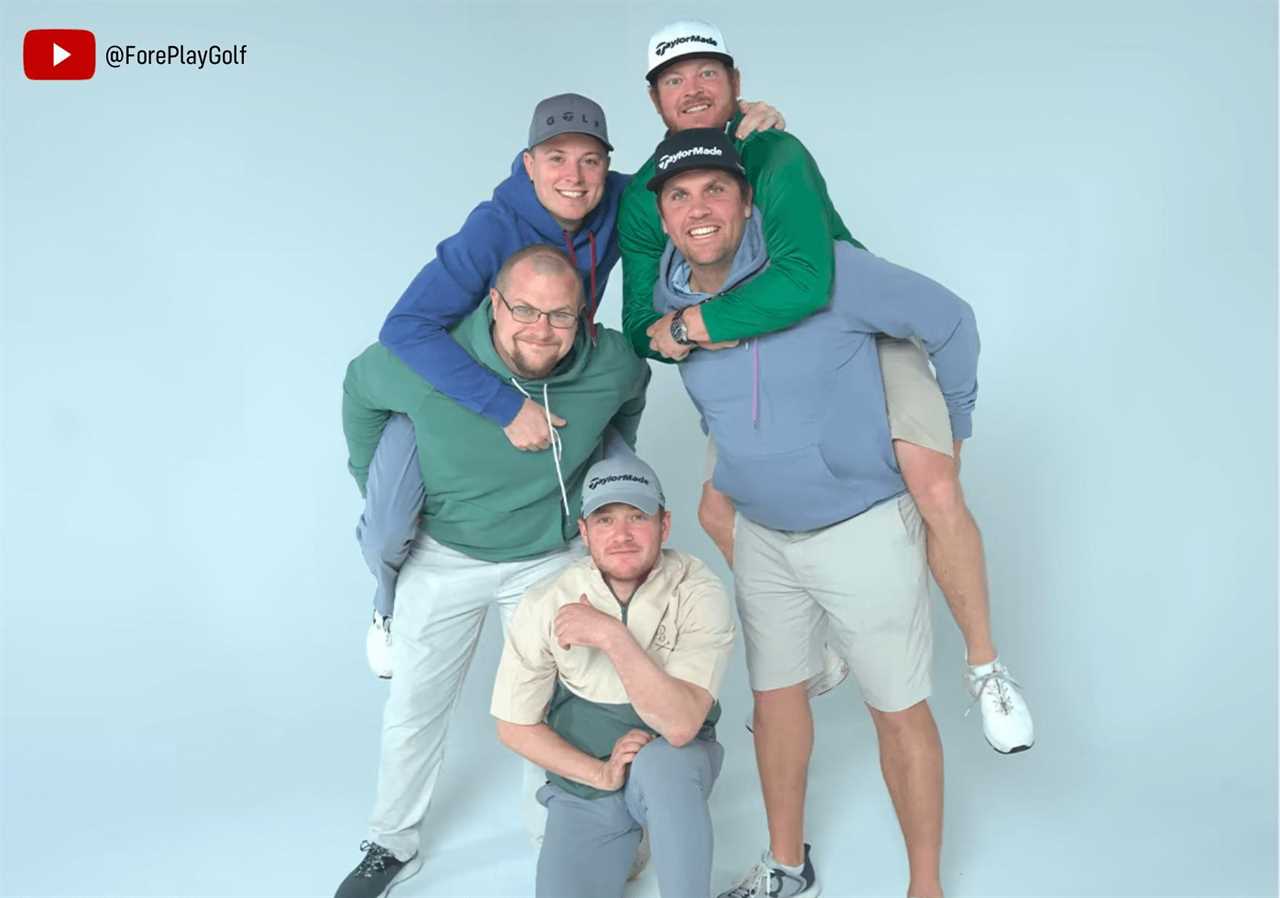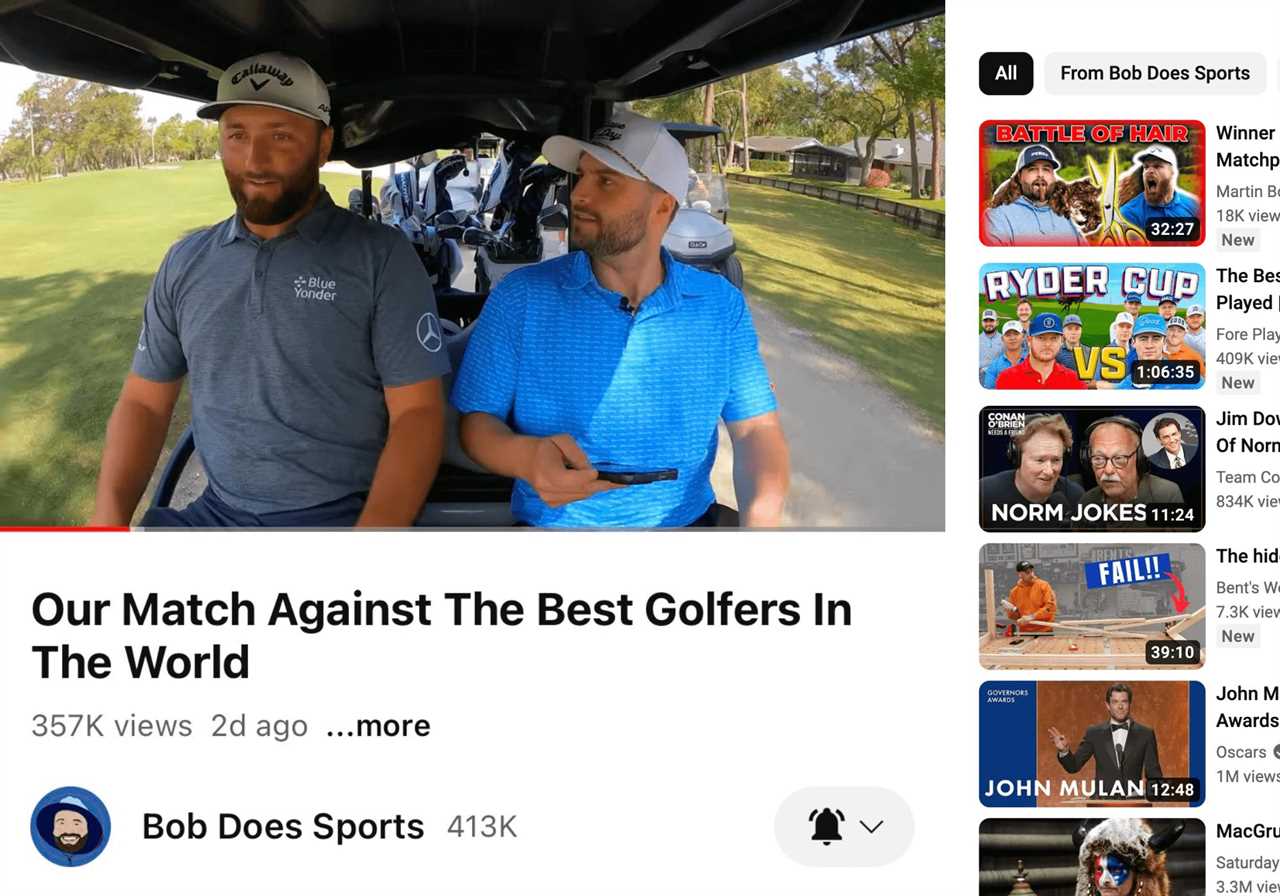In the past 15 years, watching golf has morphed into something few could have predicted.
By the millions, people are watching the game—often played by strikingly average golfers—on YouTube.
There is considerably more time spent consuming on-demand golf than any other form of passive off-course golf entertainment—including tuning into the professional game on TV.
But the story goes a lot deeper than just time. There is a whole cultural movement toward YouTube golf. Videos are brimming with hundreds of comments. Channels, boasting millions of subscribers, have their own bustling Reddit pages, entire communities dedicated to seemingly random golfers who have embraced their own unique personas like characters in a sitcom.
The golf itself is secondary. In some ways, that is the entire point of how it’s become so popular.
A personal creator-viewer relationship is being fostered, a relatability that fans of all ages are connecting with on a deep level. There is a whole genre of golf comedy. It’s attainable and believable. Viewers become invested in someone’s journey because they are witnessing each detail of that investment.
The data says golf’s younger crowd, in the 18-32 age category, is flocking to the YouTube version of golf. It’s in contrast to the average age of a PGA Tour viewer which is north of 60.
Why?
The Growing Presence of YouTube Golf

YouTube is the video home of 2.7 billion active users, making it the second most popular social media platform in the world. Almost four million new videos are uploaded each day, many of them from content creators looking to monetize their videos through YouTube’s ad system.
It’s a “brand versus brand” battleground for eyeballs.
The site hosts millions of niche offerings and one of those has become golf. There are dozens of YouTube golfers who play the game professionally, as a full-time job, despite their limited skill sets on the course.
So many channels have emerged that one golf industry friend said, “the world of YouTube golf has become very cutthroat and competitive.” It is a fierce competition of ratings and the coolest collaborations.
How popular is it? Consider that the PGA Tour—still home of the game’s best golfers despite challenges from LIV—has 1.3 million subscribers on YouTube. The Tour’s videos average about 85,000 views. There are an average of 34 “engagements” per video, meaning comments or other interactions.
This is an organization that has video rights—and access to an endless sea of present and past footage—to bring the greatest golfers in the world into everyone’s living room. It’s the best tour of pro golfers on the most popular video site in the world. The channel started 15 years ago when YouTube was gaining traction.
But the PGA Tour is an afterthought on YouTube compared to other golf channels. Compare it to GoodGood, which tabs itself as “six dudes, one golf channel.” They have 1.4 million subscribers, just slightly more than the Tour—but their videos are watched an average of 545,000 times. There are 717 engagements per video. The channel is only three years old.
GoodGood, and a host of other popular channels, have quickly lapped the Tour in connecting with golf viewers on YouTube.
Yes, professional golf is on cable TV and other streaming options (we touched on that in this piece). There is a wide audience net and substantial interest when it comes to major championships or talking about the future of the game, even if it’s frustrating fans.
At the same time, competitive professional golf lacks some of the qualities offered by YouTube (more on that in a moment). Weaknesses are being exposed.
What can you find on YouTube golf? Niches within the niche.
One popular area is instruction. Mark Crossfield (437k subscribers) is considered by many as the “original golf YouTuber” with his channel being 16 years old. He focuses on lessons and equipment reviews. Others came along and made their mark in the instruction space including Danny Maude (1.17M subscribers), MeAndMyGolf (929k subscribers), Peter Finch (569k subscribers) and Golf With Aimee (468k subscribers)
Rapid-fire golf instruction has been a part of golf magazines for decades so it makes sense that this would follow over into the on-demand video space.
More surprising is the rise of other golf entertainment forms. Rick Shiels (2.74M subscribers), “the godfather of YouTube golf”, constructed a channel that mixes instruction, competition and equipment experimenting. His most popular video of all-time is about how to cheat at golf with illegal clubs (6.6M views). Shiels has such a popular channel that Tommy Fleetwood, Rickie Fowler, Ian Poulter, Lee Westwood and other top pros have come onto his “show” to play against Shiels.
Shiels’ channel is 11 years old and it has been an inspiration to other competition-based channels sprouting up over the years. GoodGood (1.41M subscribers) and GM Golf (1.04M subscribers) were started by Garrett Clark—they feature Clark, a plus-handicap golfer, playing against other highly skilled players who have their own channels. On that list are former GoodGood members Grant Horvat (530k subscribers) and Micah Morris (471K subscribers) as well as popular channels like Bob Does Sports (680k subscribers) and Fore Play (408k subscribers).
In only 432 total videos, GoodGood has more than 357 million views. The group travels around the world to film their escapades—they even have a Reddit community of 33,000+ that discusses videos and they also have their own apparel line. It’s a full-blown business.
The channels are competing against each other but are also collaborating to raise each others’ profiles. A recent video of a match between Clark and Horvat hit one million views and over 4,000 comments within 24 hours.
There are other niches within YouTube golf. Pro golfers themselves, such as Bryson DeChambeau (461k subscribers) and Bryan Bros. Golf (305k subscribers), are building their own content while still competing in tournaments. There are platforms for niches like golf architecture and equipment reviews. Some women like Paige Spiranac (379k subscribers) have leveraged their appearance to grow their channels although Spiranac’s nearly four million Instagram followers trump her YouTube following. And some channels like hockey-based Spittin’ Chiclets (323k subscribers) post golf matches between hockey players that easily clear 500,000 views.

Another outlet that is important to note is No Laying Up (149k subscribers), which includes podcast video, an artfully produced travel series called “Tourist Sauce”, a low-budget golf travel series called “Strapped” and deep-dive golf content that delves into profound topics. NLU is an excellent example of a channel that looks at content through a particular ethos more so than maximizing attention. The audience is smaller than the most popular YouTube golf channels but serves a specific niche for a hard-core golf audience.
How much money is being made? YouTube creators receive about 55 percent of the revenue generated from ads on their channels and 1,000 views equate to roughly $18—it varies based on the channel’s popularity and engagement.
Around 100,000 views per day equates to $5,500-$9,500 of revenue per month. This is purely from targeted ads placed within the video—a lot of content has product placement or other advertising on top of that.
How much can be made? In the week prior to this article publishing, GoodGood had 2.3 million views on their videos. Accounting for all of the past month, that number was around 8.2 million views. It’s difficult to say exactly but their YouTube ad revenue is in the hundreds of thousands per month.
Why is YouTube Golf So Popular?

There are some obvious reasons behind the YouTube golf phenomenon but there is also a fascinating psychology behind it that is tough to quantify.
The most obvious reasons? The audience can watch at their convenience, engaging with a community of like-minded golf lovers. It is accessible, and free, for anyone who has an internet connection.
PGA Tour golf, or whatever competitive circuit you might enjoy, has one traditional broadcast. There are lengthy commercial breaks. If you want to watch, you have to sit through whatever the telecast shows, whether it’s a golfer you aren’t interested in or sponsored content within a broadcast—you usually don’t have another option to watch a tournament. Pro golf is regularly behind a paywall and can require multiple app subscriptions to watch. It can be a hassle at times.
With YouTube golf, there are an infinite number of videos. Successful content has to be engaging in order to produce results. Titles, graphics and the videos themselves cater to engagement above all else. Everything is edited so there is no waiting between shots. And the viewer can get hyper-specific with what type of content they want to watch within golf.
That explains a lot of it.
But we have another question.
Why do people like watching, in some cases, objectively mediocre golf?
There is a whole video series on the Fore Play channel where viewers watch Trent Ryan, a struggling golfer, attempt to first break 100—which he eventually does—and then continuously attempt to break 90. In No Laying Up’s “Strapped” series, Neil Schuster and Phil “Big Randy” Landes go to modest municipal courses and play relatively uninspiring golf. The show is more about their friendship than the golf. In Bob Does Sports, a three-man ensemble of varying low-to-high handicappers take on the likes of Jon Rahm, Max Homa, Xander Schauffele and other Tour pros.

People love it. They love watching bad golf, especially when it’s paired with significantly better golf.
It’s relatable, sure. That is part of it. But there is something else people are attracted to in these videos.
One is access. The audience sees and hears every bit of a character’s personality. The characters each have an expressed goal and a purpose, even if it’s not necessarily serious. Viewers are invested to see if they reach it. Every shot has an immediate reaction from the player who hit it.
Another is comedy. There is a lot of laughing at bad shots and celebrating the unexpected good ones. The environment is like a Saturday morning scramble amongst friends.
There are experimental formats. One-club challenges, alternate-shot matches, tournaments where a team of friends are split into two groups—anything to keep the content interesting and engaging.
We asked Clark, the driving force behind GoodGood, why he thinks his brand is successful. His answer hit on something else: organic content.
His group came together naturally. Some members were friends who grew up together in Kansas City and that slowly evolved naturally into what GoodGood is today.
“I just don’t think it would ever work to the extent that it’s worked for us if it’s not organic,” Clark said. “If you try and force it, if you try and go create a group to make money and do YouTube and that’s the sole purpose, I don’t think it would work. For us, we’ve been friends for such a long period of time… if you’re not really good friends off camera, then you definitely can’t be really good friends on camera, and it’ll shine through.”
Maybe that is it. Community matters. The group likes each other. The audience likes that that group likes each other. They feel a part of it. If you watch, you are living vicariously through them. So many of the YouTube golf channels have that same vibe.
Maybe it is not enough to just watch golf for some people. There needs to be a “why” behind it. Why does this matter?
People are now answering that question on their own.
Do you enjoy golf on YouTube? Why or why not? Let us know below in the comments.
The post The Rise of YouTube Golf: Why is On-Demand Golf so Popular? appeared first on MyGolfSpy.
https://mygolfspy.com/news-opinion/the-rise-of-youtube-golf-why-is-on-demand-golf-so-popular/
 Backyard GrillingWeekend WarriorsAdvice from DadBeard GroomingTV Shows for Guys4x4 Off-Road CarsMens FashionSports NewsAncient Archeology World NewsPrivacy PolicyTerms And Conditions
Backyard GrillingWeekend WarriorsAdvice from DadBeard GroomingTV Shows for Guys4x4 Off-Road CarsMens FashionSports NewsAncient Archeology World NewsPrivacy PolicyTerms And Conditions
